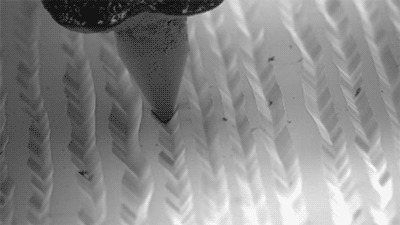Spacewalkers Successfully Connect Adapter For Commercial Crew Vehicles
Spacewalkers Successfully Connect Adapter for Commercial Crew Vehicles
ISS - Expedition 50 Mission patch / EVA - Extra Vehicular Activities patch. March 30, 2017 Expedition 50 Commander Shane Kimbrough and Flight Engineer Peggy Whitson of NASA concluded their spacewalk at 2:33 p.m. EDT. During the spacewalk, which lasted just over seven hours, the two astronauts successfully reconnected cables and electrical connections on the Pressurized Mating Adapter-3. PMA-3 will provide the pressurized interface between the station and the second of two international docking adapters to be delivered to the complex to support the dockings of U.S. commercial crew spacecraft in the future.
Image above: Spacewalkers Shane Kimbrough (spacesuit with red stripe on legs) and Peggy Whitson are pictured shortly after exiting the Quest airlock this morning. Image Credits: @Thom_Astro. The duo were also tasked with installing four thermal protection shields on the Tranquility module of the International Space Station. The shields were required to cover the port where the PMA-3 was removed earlier in the week and robotically installed on the Harmony module. During the spacewalk, one of the shields was inadvertently lost. The loss posed no immediate danger to the astronauts and Kimbrough and Whitson went on to successfully install the remaining shields on the common berthing mechanism port. A team from the Mission Control Center at NASA’s Johnson Space Center in Houston devised a plan for the astronauts to finish covering the port with the PMA-3 cover Whitson removed earlier in the day. The plan worked, and the cover was successfully installed, providing thermal protection and micrometeoroid and orbital debris cover for the port. To round out the spacewalk, Kimbrough and Whitson also installed a different shield around the base of the PMA-3 adapter for micrometeoroid protection. The shield was nicknamed a cummerbund as it fits around the adapter similar to a tuxedo’s cummerbund worn around the waist.
Image above: Astronaut Peggy Whitson signs her autograph near an Expedition 50 mission patch attached to the inside the International Space Station. Image Credit: NASA. Having completed her eighth spacewalk, Whitson now holds the record for the most spacewalks and accumulated time spacewalking by a female astronaut. Spacewalkers have now spent a total of 1,243 hours and 42 minutes outside the station during 199 spacewalks in support of assembly and maintenance of the orbiting laboratory. Related links: International docking adapters: https://www.nasa.gov/feature/meet-the-international-docking-adapter Peggy Whitson spacewalk record: https://blogs.nasa.gov/spacestation/2017/03/29/astronaut-peggy-whitson-set-to-break-spacewalk-record-thursday/ Space Station Research and Technology: https://www.nasa.gov/mission_pages/station/research/index.html International Space Station (ISS): https://www.nasa.gov/mission_pages/station/main/index.html Images (mentioned), Text, Credits: NASA/Mark Garcia. Best regards, Orbiter.ch Full article
More Posts from Fillthevoid-with-space and Others

Why do the Sun and Moon move the way they do? What’s up with that? Orbits? What? It’s a short but snug little episode here about the Sun and the Moon and how they look from Earth as they zoom across the sky.
Below the cut are my sources, music credits, a vocab list, the transcript of this episode, a composite image of the different phases of the Moon, and a list of the different names for the full moons through the course of a year. Let me know what you think I should research next by messaging me here, tweeting at me at @HDandtheVoid, or asking me to my face if you know me in real life. And please subscribe to the podcast on iTunes, rate it or review it, and maybe tell your friends about it if you think they’d like to listen!
(My thoughts on the next episode, because I still haven’t found the time to cover them, are the Voyager golden records, space race history, the transit of Venus, the Moon landing, or Edmond Halley. Let me know by the 6th and I’ll hopefully have the next podcast up on October 16th.)
Glossary
blue moon - when you get two full moons in one calendar month. An older definition is when you get 4 full moons in a season, the third moon is called the ‘blue moon.’
ecliptic - the path of the Sun over the course of a year.
prograde - when a planet spins from east to west.
retrograde - when a planet spins from west to east.
spaghettification - when extreme tidal forces pull an object apart in space.
Script/Transcript
Sources
Rising and setting times of the Sun on Earth via Cornell University
Seasons on Earth via Cornell University
Lunar phases and the Moon’s relationship to the Sun via Harvard
Tides via Hyperphysics
Tidal forces equation via AstronomyOnline.org
Tidal forces and spaghettification via NASA handout
Lunar phases composite via Fred Espenak
Names of the different full moons throughout the year via EarthSky.org
Blue moons via EarthSky.org
Intro Music: ‘Better Times Will Come’ by No Luck Club off their album Prosperity
Filler Music: ‘See The Constellation’ by They Might Be Giants off their album Apollo 18
Outro Music: ‘Fields of Russia’ by Mutefish off their album On Draught







The Moon of Lakes and Rivers - Saturn’s moon Titan
Saturn’s moon Titan is the only world - other than earth - that we know has liquid’s pooled on its surface. Unlike Earth, Titan has lakes of liquid methane - you wouldn’t want to swim in these lakes.
Titan’s “methane cycle” is analogy to Earth’s water cycle. In the 3rd and 4th images above we can see clouds of methane in Titan’s atmosphere. Ever since NASA’s Voyager 1 spacecraft, we have known that the gases that make up Titan’s brown colored haze were hydrocarbons. The atmosphere of Titan is largely nitrogen; minor components lead to the formation of methane–ethane clouds and nitrogen-rich organic smog.
It is thanks to the Cassini spacecraft that we now understand more about the climate of Titan - though we still understand very little!

The Cassini Space craft has mapped most of the Northern polar region of Titan, this is the region that contains almost all of Titan’s lakes. Cassini is systematically sweeping across Titan and mapping the surface of this strange alien world. The image below is an example of Cassini’s mapping process:

Credit: NASA/JPL/Cassini
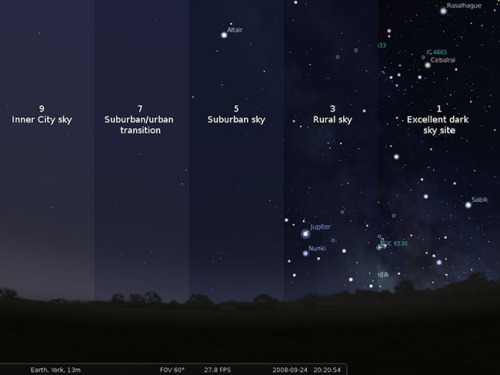
People think they know darkness, and that they experience darkness everyday, but they don’t, really.
Across the United States, natural darkness is an endangered resource. East of the Mississippi, it is already extinct; even in the West, night sky connoisseurs admit that it’s quicker to find true darkness by flying to Alice Springs, Australia, than traveling to anywhere in the lower forty-eight.
Ever since the nation’s first electric streetlight made its debut in Cleveland, on April 29, 1879, the American night has become steadily brighter. In his new book, The End of Night: Searching for Natural Darkness in an Age of Artificial Light, Paul Bogard aims to draw attention to the naturally dark night as a landscape in its own right — a separate, incredibly valuable environmental condition that we overlook and destroy at our own peril.
Read More.










Cassini prepares for final orbital “Grand Finale” at Saturn.
Erik Wernquist, the same filmmaker who created 2014’s “Wanderers” and a stunning New Horizons promotional film in 2015, has created a new video highlighting NASA’s Cassini mission’s final days at Saturn. The Cassini spacecraft will begin its final series of orbits to cap a 13-year groundbreaking science mission known as the Grand Finale. For the first time ever in Cassini’s time at Saturn, the spacecraft will fly in between the planet’s rings and atmosphere. No spacecraft has ever before flown in this region of any of the solar system’s ringed planets. After 20 orbits, Cassini will dive into Saturn’s upper atmosphere September 15 where it will be destroyed. In 2008, mission managers explored a range of End of Mission scenarios that would protect Saturn’s moon’s from Earthly contaminants before ultimately deciding on atmospheric reentry. Cassini began her End of Mission manoeuvres on November 26, 2016, when it began the first of 20 ring-grazing orbits. A close flyby of Titan April 22 will alter the spacecraft’s trajectory to begin the first of 23 orbits in the Grand Finale, which will begin April 26.

Cassini launched from Earth on October 20, 1997, and entered Saturn orbit July 1, 2004. 16 days later, the European-built Huygens probe attached to the spacecraft landed on Titan, becoming the first probe to land in the outer solar system. Originally scheduled for a four-year mission ending in 2008, Cassini received two mission extensions in 2008 and 2010, with the latter ending in 2017. With the spacecraft’s fuel reserves low, the Cassini team decided to end the mission. P/C: JPL/Erik Wernquist


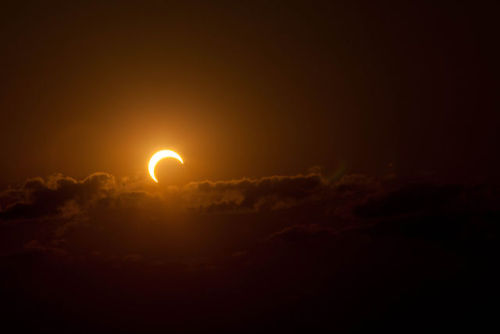

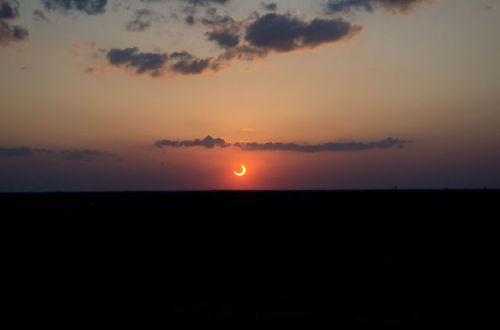


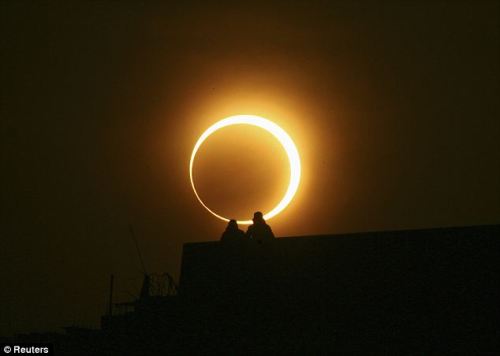
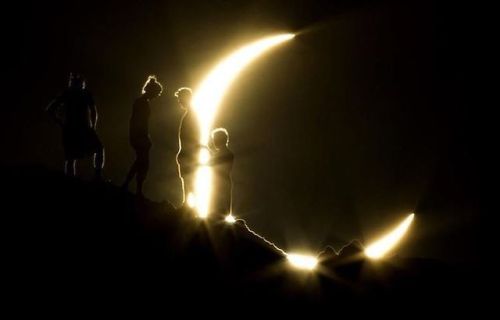
A ‘Ring of Fire’ solar eclipse is a rare phenomenon that occurs when the moon’s orbit is at its apogee: the part of its orbit farthest away from the Earth. Because the moon is so far away, it seems smaller than normal to the human eye. The result is that the moon doesn't entirely block out our view of the sun, but leaves an “annulus,” or ring of sunlight glowing around it. Hence the term “annular” eclipse rather than a “total” eclipse.

30 Doradus, located in the heart of the Tarantula nebula, is the brightest star-forming region in our galactic neighborhood. The nebula resides 170,000 light-years away in the Large Magellanic Cloud. Links to very large images in comments.
js

One-year countdown to solar eclipse, August 21, 2017: path of totality overlaid on U.S. population density and interstate map.
I was away at PodCon this weekend! It was a lovely time. Listening to people for 8 hours a day was exhausting, which I should have expected but I fully did not anticipate. I slept on a friend’s floor and passed out homemade business cards shaped like business bookmarks. It was a fun opportunity to use my typewriter! I reused some old cardstock that an office where I temped was going to throw away and I gave out 35 of 36, which is extremely successful in my book. I have some new podcasts to listen to and one or two that I want to contact about guesting on (I could go OFF about Tycho Brahe on Historical Hotties, if no one has already).
It was interesting trying to network and seeing what’s out there right now. It really is anyone’s game, podcasting. You just need time, motivation, and an idea. I shouldn’t be surprised, it was easy enough for me to do it. The hard part, of course, is getting folks to listen. There were tips I overheard about advertising yourselves and such but it still seems like it just depends on what market you tap into? I don’t know, I think the big thing is content and just persisting. I’ve seen it with podcasts I found that have a season or two and they’re gone. Sometimes it’s because they wrapped up and that’s great! Other times I wish there’d been more.
It was more fun than it was work, though! And it was so small for a con, I was relieved. The only other con I’ve gone to was Emerald City, which was also in the Washington State Convention Center, and that was Too Much. This one was a decent size. I hope it happens again! It was kind of inspiring to realize I’m part of a much, much, much larger movement of people who want to talk and made it happen.
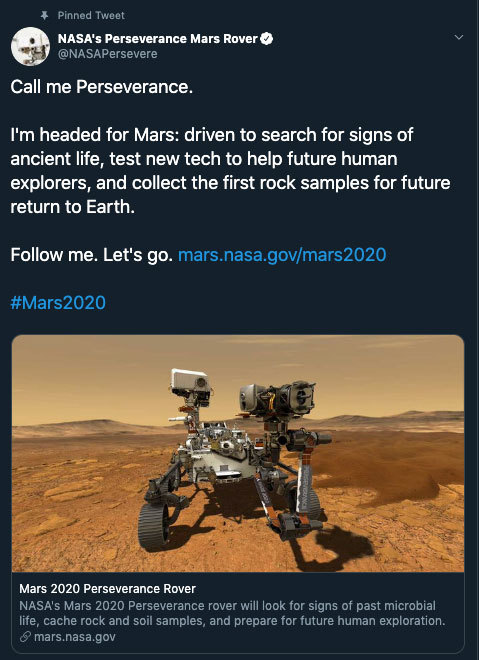
Allow us to reintroduce someone … the name’s Perseverance.
With this new name, our Mars 2020 rover has now come to life! Chosen by middle school student Alex Mather, Perseverance helps to remind ourselves that no matter what obstacles we face, whether it’s on the way to reaching our goals or on the way to Mars, we will push through. In Alex’s own words,
“We are a species of explorers, and we will meet many setbacks on the way to Mars. However, we can persevere. We, not as a nation but as humans, will not give up. The human race will always persevere into the future.”
Welcome to the family. ❤️
Make sure to follow us on Tumblr for your regular dose of space: http://nasa.tumblr.com.
-
 reflectedeve liked this · 8 years ago
reflectedeve liked this · 8 years ago -
 cohobbitation reblogged this · 8 years ago
cohobbitation reblogged this · 8 years ago -
 tinsnip reblogged this · 8 years ago
tinsnip reblogged this · 8 years ago -
 ca00-blog liked this · 8 years ago
ca00-blog liked this · 8 years ago -
 fillthevoid-with-space reblogged this · 8 years ago
fillthevoid-with-space reblogged this · 8 years ago -
 misterkrunch-blog liked this · 8 years ago
misterkrunch-blog liked this · 8 years ago -
 astronomerwithoutcause liked this · 8 years ago
astronomerwithoutcause liked this · 8 years ago -
 brashka liked this · 8 years ago
brashka liked this · 8 years ago -
 tiggerperson liked this · 8 years ago
tiggerperson liked this · 8 years ago -
 willieolsen liked this · 8 years ago
willieolsen liked this · 8 years ago -
 mrcat032 liked this · 8 years ago
mrcat032 liked this · 8 years ago -
 sykozys reblogged this · 8 years ago
sykozys reblogged this · 8 years ago -
 sykozys liked this · 8 years ago
sykozys liked this · 8 years ago -
 everfantastic liked this · 8 years ago
everfantastic liked this · 8 years ago -
 bluesunrise1 liked this · 8 years ago
bluesunrise1 liked this · 8 years ago -
 galaxsies liked this · 8 years ago
galaxsies liked this · 8 years ago -
 whoisdankeyvang reblogged this · 8 years ago
whoisdankeyvang reblogged this · 8 years ago -
 elric3087 liked this · 8 years ago
elric3087 liked this · 8 years ago -
 level37 reblogged this · 8 years ago
level37 reblogged this · 8 years ago -
 level37 liked this · 8 years ago
level37 liked this · 8 years ago -
 photowenchca liked this · 8 years ago
photowenchca liked this · 8 years ago -
 chelseyy-t liked this · 8 years ago
chelseyy-t liked this · 8 years ago -
 seekingknowlege liked this · 8 years ago
seekingknowlege liked this · 8 years ago -
 iamacar reblogged this · 8 years ago
iamacar reblogged this · 8 years ago -
 iamacar liked this · 8 years ago
iamacar liked this · 8 years ago -
 skunkcowboy liked this · 8 years ago
skunkcowboy liked this · 8 years ago -
 kerkevik reblogged this · 8 years ago
kerkevik reblogged this · 8 years ago -
 here-come-dat-spork liked this · 8 years ago
here-come-dat-spork liked this · 8 years ago -
 spaceexp reblogged this · 8 years ago
spaceexp reblogged this · 8 years ago
A podcast project to fill the space in my heart and my time that used to be filled with academic research. In 2018, that space gets filled with... MORE SPACE! Cheerfully researched, painstakingly edited, informal as hell, definitely worth everyone's time.
243 posts
